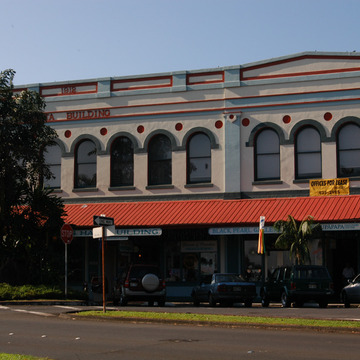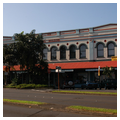Anchoring one end of Kamehameha Avenue, the S. Hata Building curves slightly, reflecting the original bend of the street. The building is well ordered and proportioned, with pilasters and round-arched windows demarcating the three bays. Pedimented parapets define the two end bays and echo the Hackfeld Building (HA33) at the other end of Kamehameha Avenue. At the pedestrian level, wrought-iron brackets with a curvilinear design fabricated by the Hilo Iron Works support the metal awning. This building was the third reinforced-concrete commercial building in Hilo and the first such building in the then predominantly Asian part of the city. The erection of a masonry building was a condition attached by the federal government in its sale of this land to Judge W. S. Wise, who then sold it to Sadanouke Hata. Hilo's foremost merchant of Japanese ancestry, Hata established his store in 1896. He sold silks, kimonos, Japanese provisions, and Japanese-themed souvenirs. He later expanded his business beyond Hilo to include two branches in Honolulu and three in Japan. During World War II, the United States seized this building, and when the government later auctioned it, the family repurchased it. It was rehabilitated in 1992, following the plans of architect Boone Morrison.
You are here
S. Hata Building
If SAH Archipedia has been useful to you, please consider supporting it.
SAH Archipedia tells the story of the United States through its buildings, landscapes, and cities. This freely available resource empowers the public with authoritative knowledge that deepens their understanding and appreciation of the built environment. But the Society of Architectural Historians, which created SAH Archipedia with University of Virginia Press, needs your support to maintain the high-caliber research, writing, photography, cartography, editing, design, and programming that make SAH Archipedia a trusted online resource available to all who value the history of place, heritage tourism, and learning.





